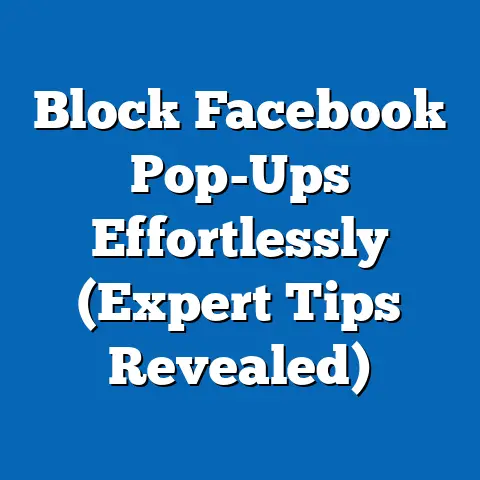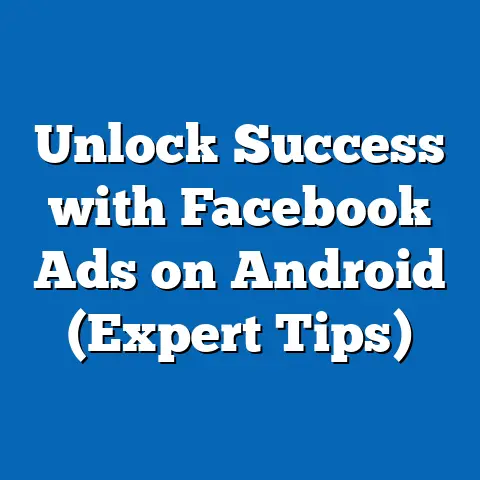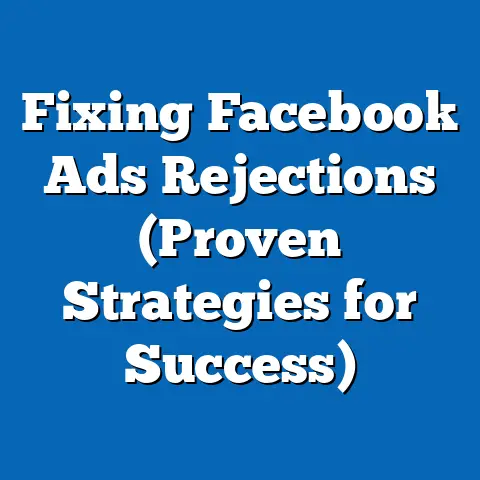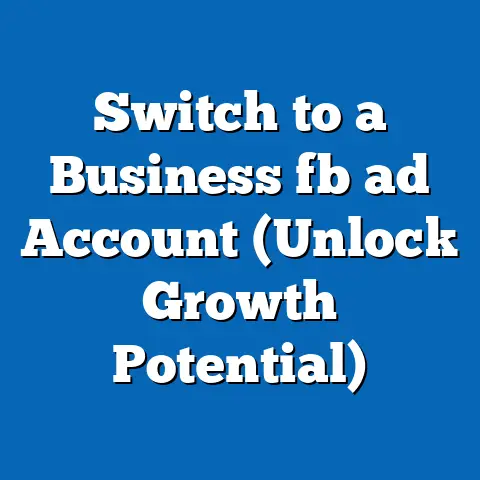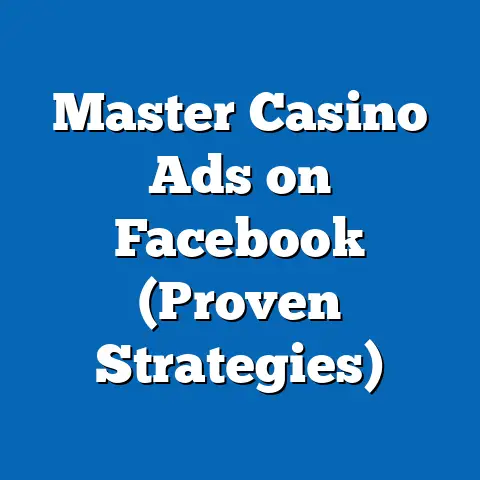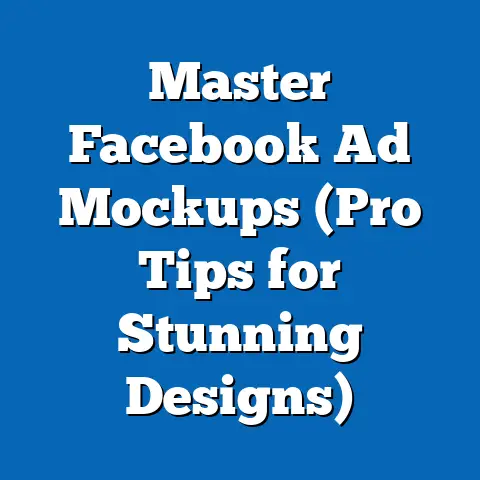Master Facebook Ads Desktop App (Unleash Its Potential)
Imagine this: it’s late, and the only light in the room is the glow of my laptop screen. I’m Sarah, a small business owner, and I’m staring at the Facebook Ads Desktop App. My desk is a chaotic landscape of sticky notes, marketing brochures, and half-empty coffee cups. I’ve poured my heart and soul into my little online store, selling handcrafted jewelry. I know Facebook ads are the key to reaching a wider audience, but the whole thing feels… daunting. Exciting, but daunting. I click through the various features, a mix of hope and anxiety swirling within me. This is my chance to move beyond my local market and tap into the vast potential of the digital world. As I dig deeper, I start to realize the sheer power this tool holds. It’s like unlocking a secret door to marketing success.
This article is for Sarah, and for anyone else who feels that mix of excitement and overwhelm when facing the Facebook Ads Desktop App. I’m going to guide you through mastering this powerful platform, helping you unlock its full potential and transform your marketing efforts. Let’s ditch the overwhelm and embrace the possibilities!
Understanding the Facebook Ads Desktop App
So, what exactly is the Facebook Ads Desktop App? It’s essentially a comprehensive platform designed for creating, managing, and analyzing your Facebook and Instagram advertising campaigns. Think of it as your command center for all things Facebook ads.
Purpose and Differences from the Mobile Version:
While the mobile app offers convenience for quick checks and basic adjustments, the desktop app provides a much richer and more robust experience. I see the mobile app as a handy sidekick, perfect for on-the-go monitoring. But the desktop app? That’s the main stage.
Here’s why:
- Greater Screen Real Estate: The desktop app allows you to view more data at once, making it easier to analyze trends and identify opportunities.
- Advanced Targeting Options: You have access to the full range of Facebook’s targeting capabilities, including detailed demographics, interests, and behaviors.
- Bulk Editing: Need to make changes to multiple ads at once? The desktop app makes bulk editing a breeze.
- Detailed Reporting: You can generate comprehensive reports that provide deep insights into your campaign performance.
- Creative Control: The desktop app provides more tools and flexibility for creating and editing your ad creatives.
User Interface and Key Features:
The user interface might seem a bit intimidating at first, but once you get the hang of it, it’s actually quite intuitive. The main components include:
- Campaigns: This is where you organize your advertising efforts by campaign objective (e.g., brand awareness, lead generation, conversions).
- Ad Sets: Within each campaign, you create ad sets that define your target audience, budget, and schedule.
- Ads: This is where you create the actual ads that will be displayed to your target audience.
- Reporting: This section provides detailed data on your campaign performance, allowing you to track key metrics and identify areas for improvement.
Why the Desktop App Matters for Serious Marketers:
I genuinely believe that the desktop app is essential for any marketer who’s serious about achieving significant results with Facebook advertising. It provides the depth, control, and analytical power needed to create highly targeted, effective campaigns.
- Intricate Campaign Management: For complex campaigns targeting multiple audiences with different messaging, the desktop app is indispensable. I’ve personally managed campaigns with dozens of ad sets, each tailored to a specific segment of my target market.
- Data-Driven Optimization: The wealth of data available in the reporting section allows you to make informed decisions about how to optimize your campaigns. It’s not just about running ads; it’s about understanding what’s working and what’s not.
- Scalability: As your business grows and your advertising efforts become more sophisticated, the desktop app will scale with you.
Takeaway: The Facebook Ads Desktop App is your central hub for creating, managing, and analyzing your Facebook and Instagram advertising campaigns. Its robust features and detailed reporting make it essential for serious marketers.
Setting Up Your First Campaign
Okay, let’s get practical. I’m going to walk you through the process of setting up your first campaign in the Facebook Ads Desktop App. Don’t worry, I’ll break it down into easy-to-follow steps.
Creating an Account and Navigating the Dashboard:
If you haven’t already, you’ll need to create a Facebook Business Manager account. This is separate from your personal Facebook profile and allows you to manage your business pages and ad accounts in one place.
- Go to business.facebook.com and click “Create Account.”
- Follow the prompts to enter your business name, contact information, and other details.
- Once your account is created, you’ll need to add your Facebook page (or create a new one) and create an ad account.
Navigating the dashboard can be a bit overwhelming at first, but here’s a quick overview:
- Left-hand Navigation: This is where you’ll find links to all the key sections of the app, including Campaigns, Ad Sets, Ads, and Reporting.
- Main Workspace: This is where you’ll see a list of your campaigns, ad sets, and ads, along with key performance metrics.
- Top Navigation: This provides access to account settings, billing information, and other administrative functions.
Setting Up a New Campaign:
Now, let’s create your first campaign.
- Click the “Create” button in the top right corner of the dashboard.
-
Choose your campaign objective. Facebook offers a variety of objectives, including:
- Brand Awareness: Increase awareness of your brand among your target audience.
- Reach: Show your ads to as many people as possible within your target audience.
- Traffic: Drive traffic to your website or app.
- Engagement: Increase engagement with your Facebook page or posts.
- Lead Generation: Collect leads from potential customers.
- App Installs: Drive installs of your mobile app.
- Video Views: Get more people to watch your videos.
- Conversions: Drive specific actions on your website or app, such as purchases or sign-ups.
- Catalog Sales: Promote products from your e-commerce catalog.
- Store Traffic: Drive traffic to your physical store locations.
-
Give your campaign a name. Choose a name that’s descriptive and easy to remember.
- Set your campaign budget. You can choose between a daily budget (the average amount you’ll spend each day) or a lifetime budget (the total amount you’ll spend over the entire campaign).
- Select your bidding strategy. Facebook offers several bidding strategies, including:
- Lowest Cost: Facebook will try to get you the most results for your budget.
- Cost Cap: You set a maximum cost per result.
- Target Cost: You set a target cost per result.
- Bid Cap: You set a maximum bid for each auction.
Choose your campaign objective. Facebook offers a variety of objectives, including:
- Brand Awareness: Increase awareness of your brand among your target audience.
- Reach: Show your ads to as many people as possible within your target audience.
- Traffic: Drive traffic to your website or app.
- Engagement: Increase engagement with your Facebook page or posts.
- Lead Generation: Collect leads from potential customers.
- App Installs: Drive installs of your mobile app.
- Video Views: Get more people to watch your videos.
- Conversions: Drive specific actions on your website or app, such as purchases or sign-ups.
- Catalog Sales: Promote products from your e-commerce catalog.
- Store Traffic: Drive traffic to your physical store locations.
Give your campaign a name. Choose a name that’s descriptive and easy to remember.
- Lowest Cost: Facebook will try to get you the most results for your budget.
- Cost Cap: You set a maximum cost per result.
- Target Cost: You set a target cost per result.
- Bid Cap: You set a maximum bid for each auction.
Defining Your Target Audience:
This is arguably the most important step in setting up your campaign. If you don’t target the right audience, your ads will be wasted.
- Define your location. You can target people who live in a specific country, region, city, or even a specific radius around a location.
- Set the age and gender of your target audience.
- Define your audience’s interests and behaviors. This is where you can really get specific. You can target people based on their interests (e.g., “yoga,” “cooking,” “travel”), their behaviors (e.g., “frequent travelers,” “online shoppers”), and their demographics (e.g., “parents,” “homeowners”).
Best Practices for Audience Targeting:
- Start Broad: When you’re just starting out, it’s often a good idea to start with a broad audience and then narrow it down based on performance.
- Use Layered Targeting: Combine multiple targeting options to create a more specific audience. For example, you could target people who are interested in “yoga” and live in a specific city.
- Test Different Audiences: Create multiple ad sets, each targeting a different audience, to see which one performs best.
- Use Lookalike Audiences: Once you have a customer list, you can create a lookalike audience based on the characteristics of your existing customers. This is a great way to find new customers who are likely to be interested in your products or services. I’ve had tremendous success with lookalike audiences, often seeing conversion rates that rival my best-performing targeted audiences.
Takeaway: Setting up your first campaign involves creating an account, defining your campaign objective, setting your budget and bidding strategy, and, most importantly, defining your target audience. Take the time to carefully consider your audience, as this will have a significant impact on the success of your campaign.
Crafting Compelling Ad Creative
You’ve got your campaign set up, your target audience defined, and your budget in place. Now it’s time to create the actual ads that will be displayed to your target audience. This is where your creativity comes into play!
Elements of Successful Ad Creative:
- Visuals: Your ad’s visuals are the first thing people will see, so they need to be eye-catching and relevant to your target audience.
- Copy: Your ad copy should be clear, concise, and persuasive. It should highlight the benefits of your product or service and include a strong call to action.
- Call to Action (CTA): Your CTA tells people what you want them to do, whether it’s to “Learn More,” “Shop Now,” “Sign Up,” or something else.
Optimizing Images and Videos for Facebook’s Specifications:
Facebook has specific requirements for image and video sizes, aspect ratios, and file types. Make sure to follow these guidelines to ensure that your ads display correctly.
- Image Size: The recommended image size for most Facebook ads is 1200 x 628 pixels.
- Video Size: The recommended video size is 1280 x 720 pixels.
- Aspect Ratio: The recommended aspect ratio for images and videos is 1.91:1.
- File Type: Facebook supports a variety of image and video file types, including JPG, PNG, MP4, and MOV.
Tips for Writing Engaging Ad Copy:
- Know Your Audience: Tailor your ad copy to the specific interests and needs of your target audience. What problems are they facing? How can your product or service help them?
- Highlight the Benefits: Focus on the benefits of your product or service, rather than just the features. How will it improve their lives?
- Use Strong Verbs: Use action-oriented verbs that encourage people to take action.
- Keep it Concise: People have short attention spans, so keep your ad copy short and to the point.
- Include a Clear Call to Action: Tell people exactly what you want them to do.
My Personal Experience:
I once ran a campaign for a local bakery, and their initial ad copy was bland and generic. It simply stated, “We sell delicious cakes and pastries.” I rewrote the copy to focus on the emotional connection people have with baked goods, highlighting the joy of sharing a cake with loved ones or the comfort of indulging in a warm pastry on a cold day. The new ad copy resonated much more strongly with the target audience, resulting in a significant increase in click-through rates and conversions.
Takeaway: Compelling ad creative is essential for capturing the attention of your target audience and driving results. Pay attention to your visuals, copy, and call to action, and make sure to optimize your ads for Facebook’s specifications.
Budgeting and Bidding Strategies
You’ve got your campaign set up, your target audience defined, and your ad creatives ready to go. Now it’s time to talk about money. How much should you spend on your Facebook ads, and how should you bid for ad placements?
Setting an Appropriate Budget:
There’s no one-size-fits-all answer to this question. The appropriate budget will depend on your business goals, your target audience, and your industry.
- Start Small: When you’re just starting out, it’s often a good idea to start with a small budget and then gradually increase it as you see results.
- Consider Your Customer Lifetime Value: How much is each customer worth to your business over the long term? This will help you determine how much you can afford to spend to acquire a new customer.
- Think About Your Conversion Rate: What percentage of people who click on your ad actually convert into customers? This will help you calculate your cost per acquisition (CPA).
Daily vs. Lifetime Budgets:
- Daily Budget: This is the average amount you’ll spend each day on your ads. Facebook will try to spend this amount each day, but it may fluctuate slightly.
- Lifetime Budget: This is the total amount you’ll spend over the entire campaign. Facebook will try to spend this amount evenly over the duration of the campaign.
Choosing the Right Budget Type:
For campaigns where I want consistent daily results, I usually opt for a daily budget. However, for short-term promotions or campaigns with a specific end date, a lifetime budget can be more efficient.
Bidding Strategies:
Facebook offers several bidding strategies, each with its own pros and cons.
- Lowest Cost: Facebook will try to get you the most results for your budget, without regard to cost per result. This is a good option if you’re just starting out and you’re not sure how much you should be paying for each result.
- Cost Cap: You set a maximum cost per result. Facebook will try to get you as many results as possible, while staying within your cost cap. This is a good option if you have a specific CPA target in mind.
- Target Cost: You set a target cost per result. Facebook will try to get you results at your target cost, but it may not always be able to do so. This is a good option if you’re willing to pay a slightly higher cost per result in order to get more consistent results.
- Bid Cap: You set a maximum bid for each auction. Facebook will never bid more than your bid cap, even if it means you don’t get as many results. This is a good option if you’re very price-sensitive and you want to make sure you’re not overpaying for ad placements.
A/B Testing Ads:
A/B testing involves creating multiple versions of your ads and then testing them against each other to see which one performs best. This is a critical step in optimizing your campaigns.
- Test Different Visuals: Try different images, videos, and ad formats.
- Test Different Copy: Experiment with different headlines, body text, and calls to action.
- Test Different Audiences: See which audiences respond best to your ads.
Takeaway: Budgeting and bidding are critical aspects of Facebook advertising. Start with a small budget, consider your customer lifetime value and conversion rate, and experiment with different bidding strategies to find what works best for you. Don’t forget to A/B test your ads to optimize your performance.
Monitoring and Analyzing Ad Performance
You’ve launched your campaign, your ads are running, and now it’s time to see how they’re performing. Monitoring and analyzing your ad performance is essential for optimizing your campaigns and achieving your business goals.
Analytics Tools in the Facebook Ads Desktop App:
The Facebook Ads Desktop App provides a wealth of data on your campaign performance. You can access this data in the “Reporting” section of the app.
- Overview: This provides a high-level summary of your campaign performance, including key metrics like reach, impressions, clicks, and conversions.
- Demographics: This shows you the demographics of the people who are seeing your ads, including their age, gender, location, and interests.
- Placement: This shows you where your ads are being displayed, including Facebook, Instagram, Audience Network, and Messenger.
- Delivery: This shows you how your ads are being delivered to your target audience, including the frequency of impressions and the cost per result.
Key Performance Indicators (KPIs) to Track:
- Reach: The number of unique people who saw your ads.
- Impressions: The number of times your ads were displayed.
- Click-Through Rate (CTR): The percentage of people who saw your ad and clicked on it.
- Conversion Rate: The percentage of people who clicked on your ad and completed a desired action, such as making a purchase or signing up for a newsletter.
- Cost Per Click (CPC): The average cost you paid for each click on your ad.
- Cost Per Acquisition (CPA): The average cost you paid for each conversion.
- Return on Ad Spend (ROAS): The amount of revenue you generated for every dollar you spent on advertising.
Interpreting Data and Making Informed Adjustments:
- Identify Trends: Look for patterns in your data. Are certain ads performing better than others? Are certain audiences more responsive to your ads?
- Adjust Your Targeting: If you’re not reaching the right people, adjust your targeting to be more specific.
- Optimize Your Ad Creative: If your ads aren’t getting enough clicks, try different visuals or copy.
- Adjust Your Budget: If your ads are performing well, consider increasing your budget. If they’re not performing well, consider decreasing your budget or pausing the campaign.
My Real-World Example:
I was running a campaign for an e-commerce store selling handmade soaps. I noticed that my ads were getting a lot of impressions but not many clicks. After analyzing the data, I realized that my ad copy was too generic and didn’t highlight the unique benefits of the soaps. I rewrote the copy to focus on the natural ingredients and the luxurious feel of the soaps, and the CTR immediately increased.
Takeaway: Monitoring and analyzing your ad performance is crucial for optimizing your campaigns and achieving your business goals. Use the analytics tools in the Facebook Ads Desktop App to track key metrics, identify trends, and make informed adjustments to your campaigns.
Advanced Features and Techniques
Now that you’ve mastered the basics of Facebook advertising, let’s dive into some advanced features and techniques that can help you take your campaigns to the next level.
Custom Audiences:
Custom audiences allow you to target people who have already interacted with your business, such as website visitors, email subscribers, or app users.
- Website Custom Audiences: Target people who have visited specific pages on your website.
- Customer List Custom Audiences: Upload a list of your customer email addresses or phone numbers to target them with your ads.
- App Activity Custom Audiences: Target people who have taken specific actions in your mobile app.
- Engagement Custom Audiences: Target people who have engaged with your Facebook page or posts.
Lookalike Audiences:
Lookalike audiences allow you to target people who are similar to your existing customers.
- Source Audience: You start with a source audience, such as your customer list or website visitors.
- Similarity: You choose how similar you want the lookalike audience to be to the source audience. A smaller percentage will result in a more similar audience, while a larger percentage will result in a larger, but less similar, audience.
Retargeting Strategies:
Retargeting involves showing ads to people who have already interacted with your business, but haven’t yet converted into customers.
- Website Retargeting: Show ads to people who have visited your website but haven’t made a purchase.
- Product Retargeting: Show ads for specific products that people have viewed on your website.
- Cart Abandonment Retargeting: Show ads to people who have added items to their shopping cart but haven’t completed the purchase.
Facebook Pixel:
The Facebook Pixel is a small piece of code that you install on your website. It allows you to track conversions, optimize your campaigns, and build custom audiences.
- Track Conversions: See which ads are driving the most conversions on your website.
- Optimize Campaigns: Optimize your campaigns for specific conversion events, such as purchases or sign-ups.
- Build Custom Audiences: Create custom audiences based on website visitors.
Dynamic Ads and Catalog Sales for E-Commerce Businesses:
Dynamic ads allow you to automatically show ads for products that people have viewed on your website or in your mobile app.
- Upload Your Product Catalog: Upload a catalog of your products to Facebook.
- Create a Dynamic Ad Template: Create a template for your dynamic ads, specifying the information you want to display, such as the product name, price, and image.
- Facebook Will Automatically Show Ads: Facebook will automatically show ads for products that people have viewed, based on their browsing history.
My Insider Tip:
I’ve found that combining custom audiences with lookalike audiences can be incredibly powerful. For example, I create a custom audience of my most valuable customers and then create a lookalike audience based on that custom audience. This allows me to target new customers who are likely to be just as valuable as my existing customers.
Takeaway: Advanced features and techniques like custom audiences, lookalike audiences, retargeting, the Facebook Pixel, and dynamic ads can help you take your Facebook advertising campaigns to the next level. Experiment with these features to see what works best for your business.
Troubleshooting Common Issues
Even the most experienced Facebook advertisers run into problems from time to time. Here are some common issues and how to troubleshoot them.
Ad Rejections:
Facebook has strict advertising policies, and your ads may be rejected if they violate these policies.
- Review the Advertising Policies: Familiarize yourself with Facebook’s advertising policies to ensure that your ads comply.
- Edit Your Ad: If your ad is rejected, edit it to comply with the policies and resubmit it.
- Appeal the Decision: If you believe your ad was rejected in error, you can appeal the decision.
Low Ad Reach:
If your ads aren’t reaching enough people, there are several things you can try.
- Increase Your Budget: A higher budget will allow you to reach more people.
- Expand Your Targeting: Broaden your targeting to include more people.
- Improve Your Ad Relevance: Make sure your ads are relevant to your target audience.
- Increase Your Bid: A higher bid will increase your chances of winning ad auctions.
Audience Targeting Mistakes:
- Overlapping Audiences: Make sure your ad sets don’t target the same audiences. Overlapping audiences can lead to inefficient ad delivery.
- Too Narrow Targeting: If your targeting is too narrow, you may not be reaching enough people.
- Incorrect Demographics: Double-check your demographics to make sure you’re targeting the right age, gender, and location.
Maintaining Compliance with Facebook’s Advertising Policies:
- Stay Up-to-Date: Facebook’s advertising policies are constantly evolving, so make sure to stay up-to-date.
- Be Transparent: Be transparent about your products or services.
- Avoid Misleading Claims: Don’t make false or misleading claims in your ads.
- Respect User Privacy: Respect user privacy and don’t collect or use data in a way that violates Facebook’s policies.
My Go-To Solution:
When I’m struggling with ad rejections, I always double-check my landing page. Facebook scrutinizes landing pages to ensure they align with the ad’s promise and don’t contain misleading information. Often, a simple tweak to the landing page can resolve the rejection issue.
Takeaway: Troubleshooting common issues is an essential part of Facebook advertising. Be prepared to address ad rejections, low ad reach, and audience targeting mistakes. Always maintain compliance with Facebook’s advertising policies and guidelines.
Conclusion: Empowering Marketers with the Facebook Ads Desktop App
We’ve covered a lot of ground in this guide, from understanding the basics of the Facebook Ads Desktop App to exploring advanced features and troubleshooting common issues. I hope you now feel empowered to unleash the full potential of this dynamic tool in your marketing arsenal.
Mastering the Facebook Ads Desktop App is not just about learning the technical aspects of the platform. It’s about understanding your target audience, crafting compelling ad creative, and making data-driven decisions. It’s about connecting with people, solving their problems, and building lasting relationships.
Remember Sarah, the small business owner I introduced at the beginning of this article? She’s now running highly targeted, effective Facebook ad campaigns that are driving significant results for her business. She’s reaching new customers, increasing her sales, and building a loyal following. And you can do the same!
The Facebook Ads Desktop App is a powerful tool that can transform your marketing efforts, regardless of your business size or industry. Don’t be afraid to dive in, experiment, and learn from your mistakes. The more you use the platform, the more comfortable and confident you’ll become.
So, go ahead, unleash the power of the Facebook Ads Desktop App and take your marketing to the next level!

